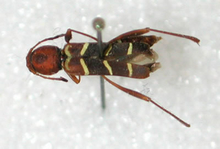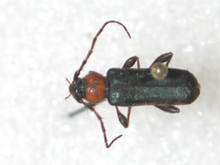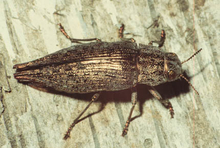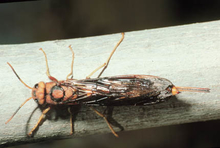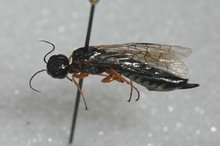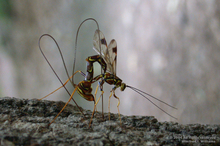Quick facts
Some insects may be brought into homes on wood (especially firewood and lumber), seeds and nuts. These insects are a nuisance and do NOT reinfest wood or other products.
- Most wood-boring insects attack trees or branches that are weak, drought-stricken, diseased, dying or recently dead.
- They can also be found on trees that have recently been blown down or felled.
- You may find more nuisance insects in firewood or lumber from damaged trees than in wood from healthy trees.
Damage caused by nuisance wood borers
Nuisance insects are different from powderpost or deathwatch beetles that can reinfest wood and cause extensive damage.
Wood-boring insects tunnel in the wood as they feed.
- In most cases, the damage is cosmetic and does not affect the structure of the wood.
- Exit holes that are formed by the adults when they exit the wood can be seen.
Adults have very specific requirements:
- They lay their eggs only in the bark of green wood.
- These insects do not lay eggs on logs without bark, dried, sawed, painted or finished wood.
Generally, only a few insects emerge, but sometimes larger numbers are seen.
How do nuisance wood borers get indoors
Nuisance insects are commonly brought in with firewood, but they can also be brought into homes in lumber used for construction or remodeling, decorative items (e.g. wreaths) and furniture.
- Insects feeding in the tree at the time of harvest remain inside even after the tree is processed into lumber.
- Some insects continue to develop and complete their life cycle once the lumber is used in the house.
- This can cause concern to homeowners (but little economic damage) as they bore out of the wood and anything that covers it (e.g., drywall, linoleum, paneling or moldings).
- These insects will NOT reinfest wood in structures after they have emerged.
Insects can also enter homes inside acorns, nuts or seeds brought in for decoration or as food.
- The weevils (grubs) crawl out of acorns or nuts and attempt to hide under rugs or other objects.
- Other nuts or seeds such as hazelnuts, walnuts or honeylocust pods can contain similar insects.
How to get rid of nuisance wood borers
No pesticide treatments are needed to control these nuisance wood borers and seed insects.
- They are only a temporary nuisance and die or go away on their own.
- If you see nuisance wood borers and seed insects, physically remove them by hand or with a vacuum.
- Remember that these insects are harmless to humans and cannot infest seasoned wood.
The best way to manage these pests is to prevent them from coming into homes.
- To prevent insects from coming in with firewood, leave the wood outside or in an unheated shed or garage.
- Bring in a small supply as it is needed.
- This way the wood will be burned before the insects emerge.
- To prevent them from being imported when remodeling or replacing infested wood, use only kiln-dried lumber.
- Do not treat logs or lumber with pesticides to control these insects.
Behavior and habits of nuisance wood borers
Pictures of different types of wood-boring insects are provided below. Insects discussed in this section include: longhorned beetles, metallic wood borers, wood wasps, horntails, bark beetles, parasitic wasps and weevils (snout beetles).
Most of these insects are weevils, and are found as legless, plump, white grubs. These grubs develop into long-snouted adult weevils.
Longhorned beetles
(Family Cerambycidae)
They are one of the most common groups of nuisance wood borers.
- Medium to large (some are as large as 2 inches), dull to brightly colored insects.
- They can be recognized by their elongate oval body shape and long antennae (half the length of the body or longer).
- Commonly found longhorned beetles in homes are: the tanbark borer (Phymatodes testaceus) and the redheaded ash borer (Neoclytus acuminatus).
Metallic wood borers
(Family Buprestidae)
They get their name from the metallic sheen that many of them have as adults.
-
These insects are medium to large (1½ inches), bullet to oval-shaped, with short antennae.
-
The flatheaded appletree borer (Chrysobothris femorata) is a metallic wood borer that can be found in structures in Minnesota.
Wood wasps and horntails
Wood wasps (Family Xiphydriidae) and horntails (Family Siricidae) are both non-stinging wasps that bore into wood.
-
Wood wasps are slender insects less than ¾ inch long that normally infect small branches of deciduous trees.
-
Horntails are more than an inch long, and have a horn-like projection extending back from the abdomen. Horntails attack both deciduous and coniferous trees.
Bark beetles
(Family Scolytidae)
-
They are small (1/8-¼ inch long), robust reddish brown to black insects.
-
They are very common in the landscape, and can emerge from many types of wood brought into homes.
Parasitic wasps
(Families Braconidae and Ichneumonidae)
-
Small to large parasitic wasps (e.g. Ichneumonid wasps) that attack wood borers can also be found coming out of wood.
-
They are small to large in size and can be differentiated from wood wasps by their more slender waists.
Weevils
(Family Curculionidae)
-
They are called snout beetles and are can be identified by the beak-like projection on their head.
-
They are small (1/16-3/8 inch), dark beetles that feed in wood, seeds and nuts.
-
Small, whitish, legless weevil larvae maybe found in seed and nuts brought into homes.
During the summer, most wood-boring insects feed in the wood and bark of trees and shrubs.
- These insects frequently spend the winter inside the tree as larvae or pupae, and emerge in the spring as adults.
- Many of these insects complete their life cycle in one year.
- When they are brought into homes in lumber or other wood products, they can finish development and can emerge at any time of year.
Reviewed in 2024


